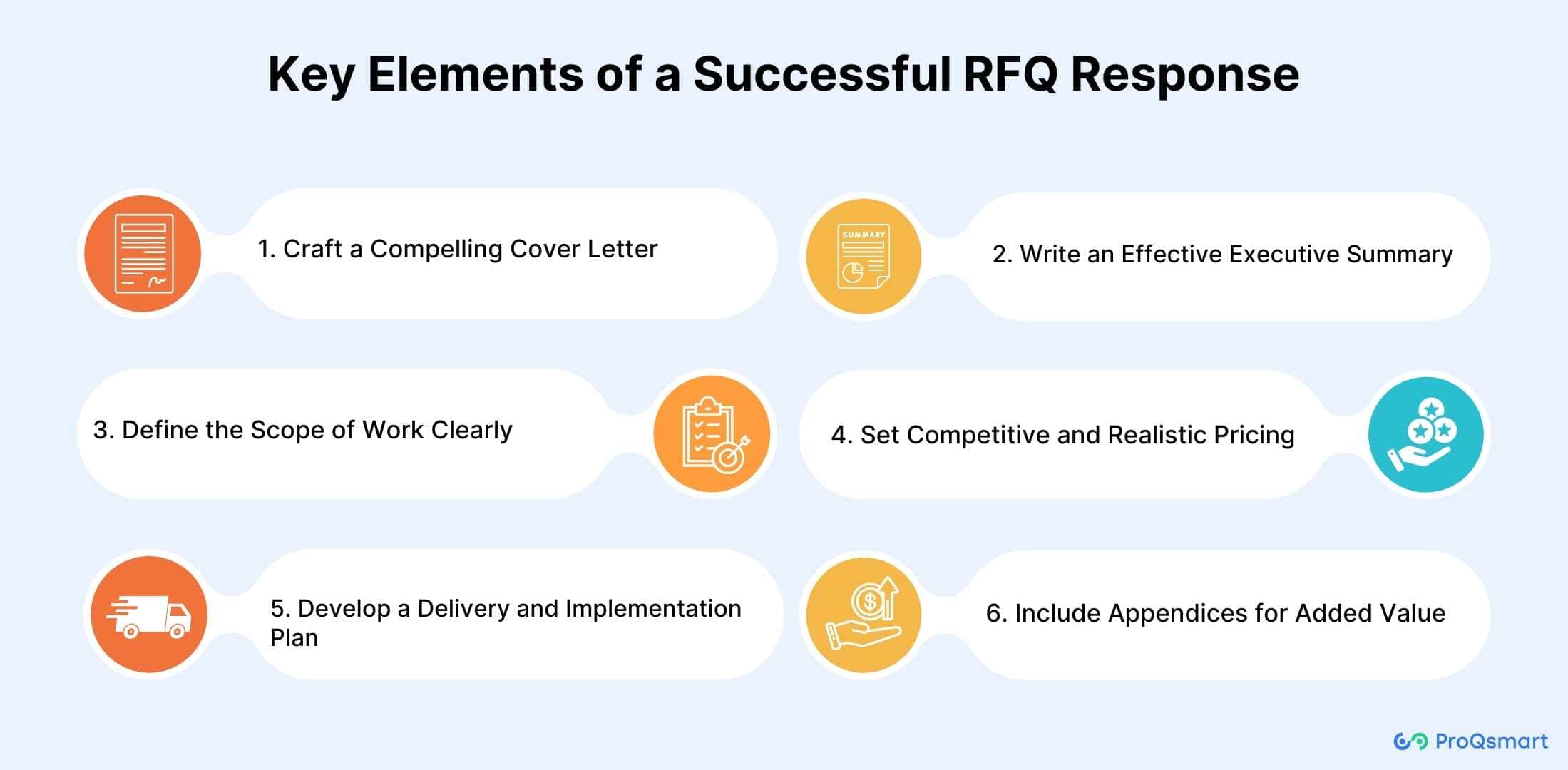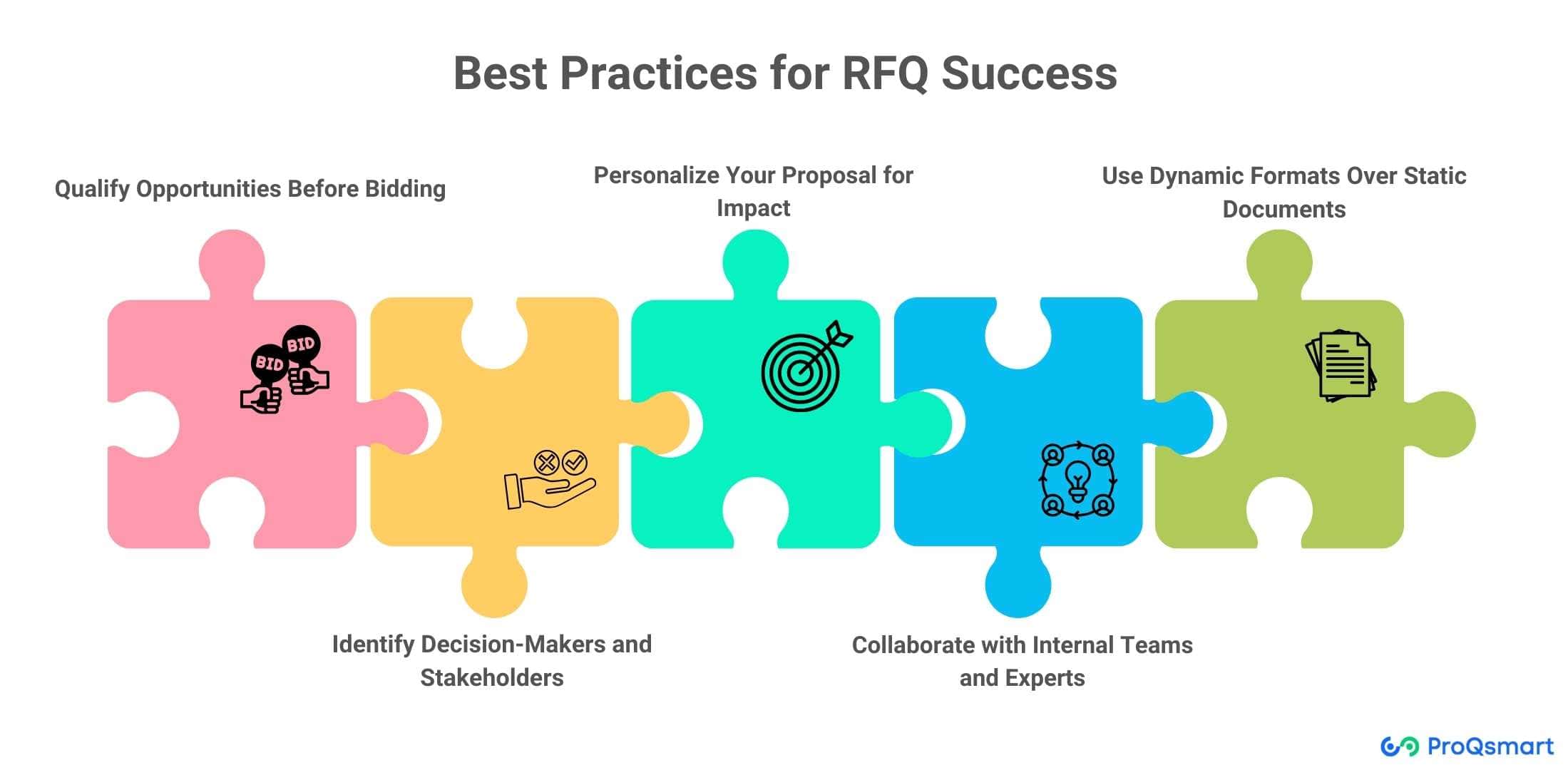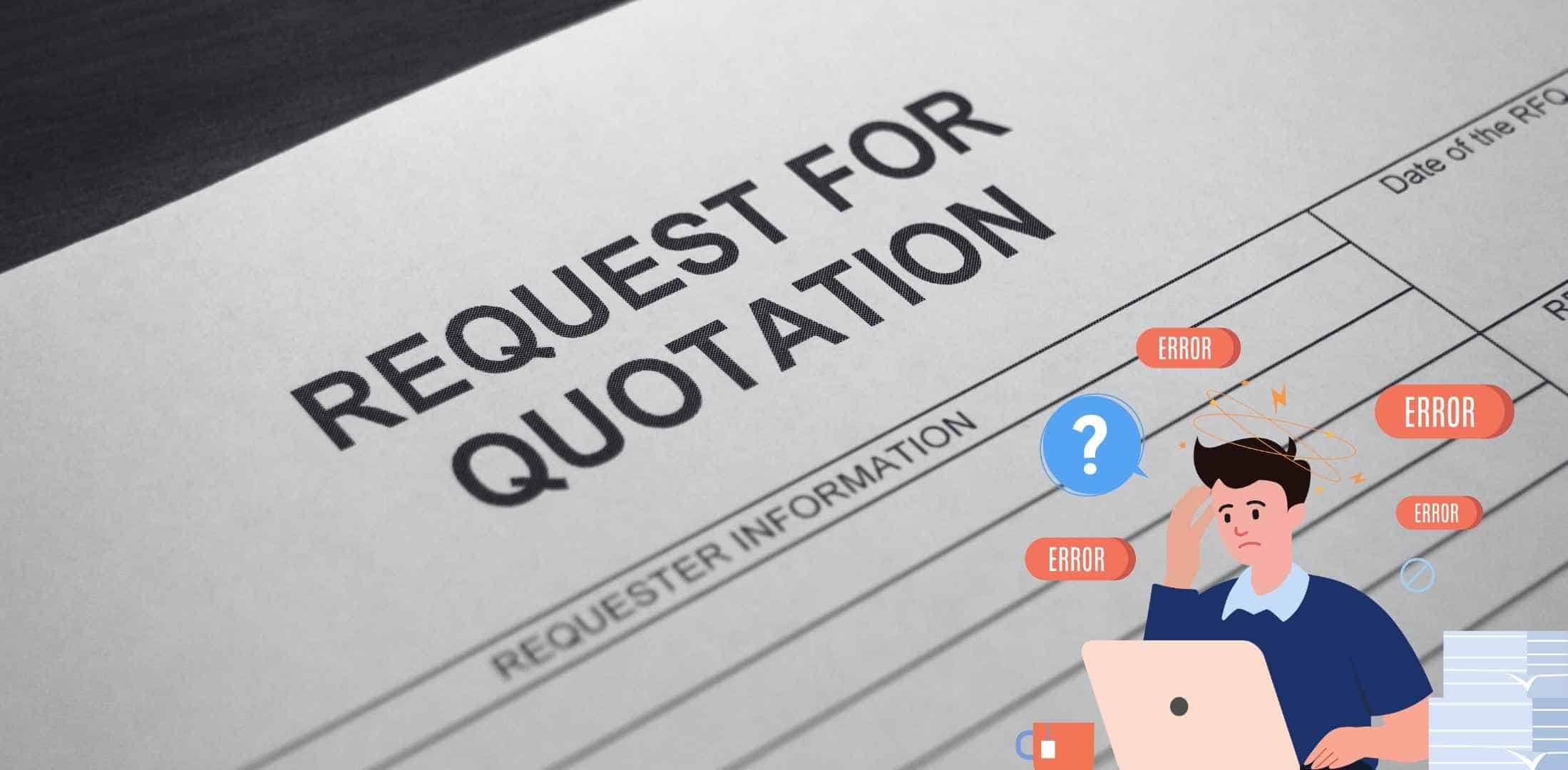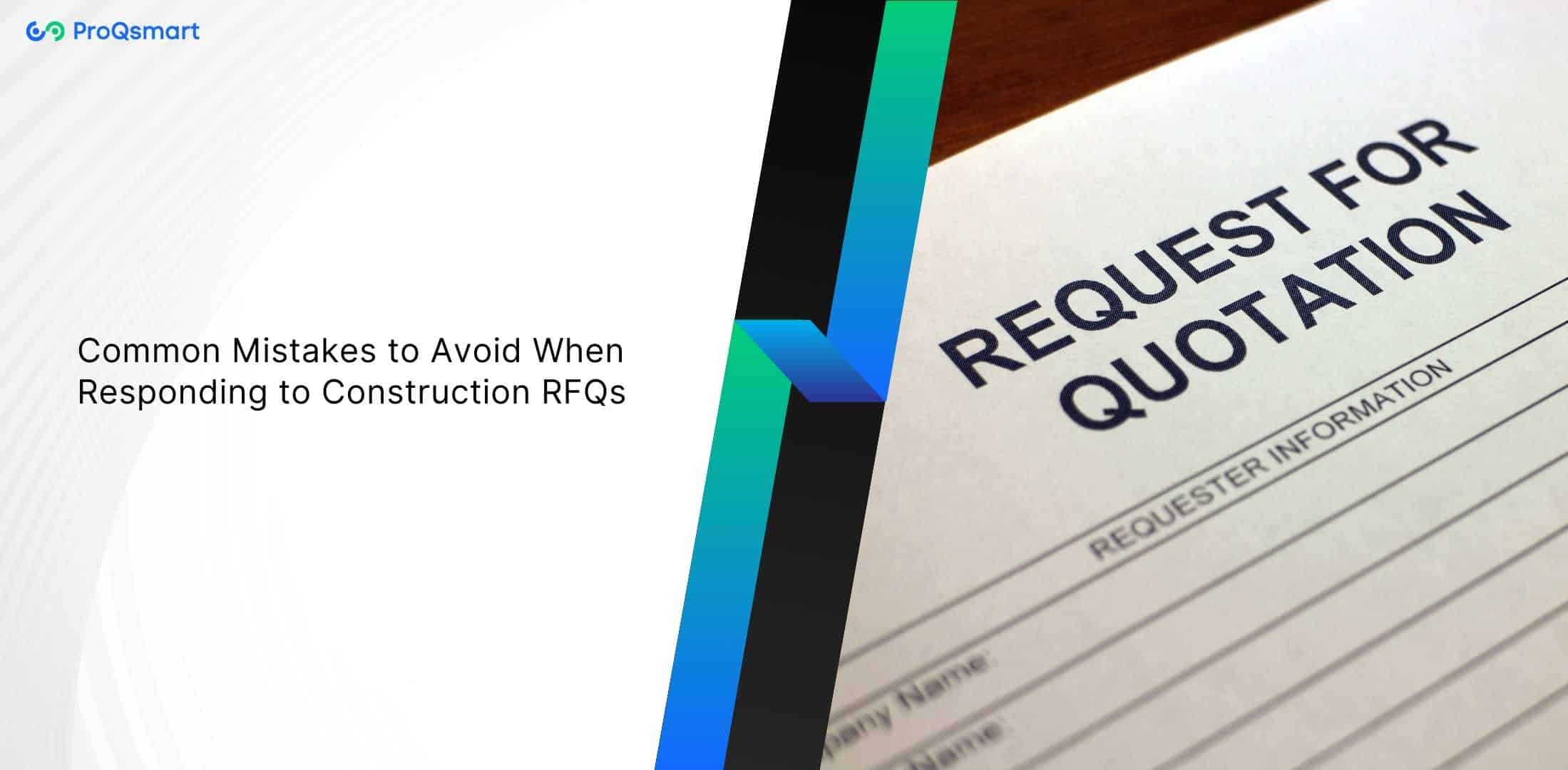Astonishingly, 40% of contractors stumble when crafting their construction RFQ responses. You need to dodge these common pitfalls.
Read the RFQ requirements closely. Missing details can cost you. Write proposals that are clear and to the point.
Show your skills and experience boldly. Don’t just talk; prove your worth with examples. Winning contracts isn’t about luck; it’s about strategy.
Understanding what clients want makes your proposal shine. Keep it simple, yet powerful. Use words that pack a punch.
Share your know-how with authority. Impress with facts, not fluff. Stand out in the crowd by mastering these best practices.
Contracts are within reach. You have the tools; now use them to win. Let’s make RFQs work for you.
Key Takeaways
- Learn the common mistakes on RFQs so you can submit a better response. Learn common mistakes of RFQ (like vagueness and omissions) to improve your submissions.
- Instead, focus on the necessary elements of a successful RFQ response. Clear project scope, thorough pricing, and examples of past success give prospects the trust they need to move forward.
- Use best practices for RFQ success. Answer for the specific client, give a thorough answer, and keep everything professional in the submission.
- Develop strategies to avoid those common RFQ mistakes. Check your submissions carefully before you send them. Do team revisits and ask for feedback to improve your submission process.
- Use technology to your advantage in your RFQ response process. Use software tools to manage projects and communicate to ensure your replies are more efficient and accurate.
- Stay informed about industry trends and updates. Keep yourself updated on the latest trends in the construction sector. This knowledge will enable you to adjust your RFQ strategies to the changing market conditions.
Understanding RFQ Mistakes
Writing a quote for a construction RFQ can be challenging. Understanding the RFQ process and avoiding common pitfalls can significantly impact your bid success. Let’s explore the typical mistakes and their implications for effective project management in construction.
Common Errors in RFQ Responses
One of the most common mistakes contractors make is simple clerical errors. These can be everything from typographical errors in the submission to incorrect project specifications. Imagine if a contractor spelled a key term wrong or gave the wrong number on something.
Mistakes like these — small as they may seem — can confuse clients and make the contractor appear unprofessional.
Another huge mistake is to not address all the evaluation criteria spelled out in the RFQ. Each RFQ sits on top of a set of requirements and criteria that evaluators use to judge bids. Neglect any of these elements, and your proposal will be rejected.
This demonstrates carelessness with details and ignorance of the project. If a bidder does not demonstrate their experience in sustainable building practices, as described in the RFQ, their bid could be compromised. This omission can make you uncompetitive during the bidding process.
Even many contractors rely extensively on boilerplate content, cobbling together standard responses with little tailoring. This approach allows for a real time saver. However, this can backfire when the content doesn’t align with the unique requirements of the current project.
An RFQ for a high-rise demands different skill sets than a suburban build. Tailored responses are crucial to demonstrate the unique skills and experiences applicable to each project.
Moreover, failing to thoroughly proofread can lead to mathematical errors in pricing. Imagine submitting a bid with a miscalculated total cost due to a simple arithmetic mistake—it could significantly affect the project’s feasibility and your credibility.
Proofreading ensures that all figures are accurate, preventing costly errors and demonstrating professionalism.
Consequences of Mistakes in RFQs
Common mistakes in RFQs can have dire consequences. At the front end, they can cost you contracts and result in a tarnished reputation. It can raise red flags for clients if you submit a response with errors.
This conveys that the contractor might not be trustworthy or able to produce good work. That perception can harm prospects in the future and damage a contractor’s reputation in the industry.
Financial losses are another possible outcome of inaccurate bids or overlooked requirements. Submitting a bid based on incorrect calculations or missing elements can result in increased project costs or reduced margins, impacting profitability.
For example, underestimating the cost of materials due to a clerical error can lead to financial strain as the project progresses.
You will pay for repeated errors with your clients in the long term. Repetitive errors can damage trust in the process and can make clients wary of using the contractor for future projects.
In a competitive industry, solid client relationships are essential, and repeated mistakes lead to losing those relationships.
Errors can also result in project delays and increased expenses. The contractor may need to revise or even resubmit a proposal, which means the project won’t get started as quickly.
Mistakes made in planning or budgeting can complicate the project once it gets underway. These mistakes cause delays and raise costs.
Key Elements of a Successful RFQ Response

1. Craft a Compelling Cover Letter
When you kick off an RFQ response, the cover letter is the very first thing the client sees. We need to strengthen the opening statement. It needs to capture attention and set the right tone for the whole proposal. Think of it as the handshake that starts a conversation.
Show how our key qualifications and experiences align with the project requirements. This will make it obvious right from the start that we’d be just the company for the job. Personalization is key here, too. We also understand what the client’s true needs and goals are. This shows we really understand what they’re seeking.
It’s almost like you’re speaking their language, and that is really persuasive. It’s important that we are clear and direct. We also avoid jargon, so we keep things crisp and clear.
2. Write an Effective Executive Summary
The executive summary is the elevator pitch of the proposal. In this instance, we bullet our key takeaways, with an emphasis on our unique selling propositions. It’s where we make our argument for why our firm is different.
We have to be able to talk about benefits clearly, in a way that actually interests evaluators—that makes them want to find out more and read on. The executive summary must hit all the important points of the proposal. It’s about finding that balance of just enough information but not too much.
A great executive summary can change how you tackle it. With the right strategy and tools, it’ll actually boost your win rates by an impressive 31%.
3. Define the Scope of Work Clearly
A detailed scope of work is critical to avoid miscommunication down the road. We need to define tasks, deliverables, and project requirements in the finest detail, so all stakeholders know exactly what they’re getting.
In clear language, we define roles and establish expectations to enable project success. Adding timelines and milestones gives a roadmap, demonstrating both to the client and to our team the path the project will take.
Aligning the scope of work with the client’s objectives and budget is key. It shows we know their limitations and will play within them.
4. Set Competitive and Realistic Pricing
Pricing is an area where there is a real fine line, especially in the construction industry. We conduct deep market analysis to understand competitive rates for construction projects of that type. A detailed breakdown of costs in our rfq process increases transparency, providing the client with trust.
There’s a truth to the maxim that the cheapest bidder doesn’t always win. Instead, it should be value, quality, and experience. We justify our pricing based on quality, experience, and project complexity.
This approach proves that our pricing reflects the true value of what we offer. It can
1) increase perceived value and
2) differentiate our proposal in the construction market.
5. Develop a Delivery and Implementation Plan
The effective delivery and implementation plan explains how we want to deliver the project from beginning to end. It should include timelines, resource allocation, and strategies for overcoming potential challenges.
This plan must correlate with client needs and project deadlines, demonstrating our preparedness. By including contingency plans, you show that you anticipate the unexpected and make the client feel you’re prepared and ready for anything.
This level of planning sets us up as trusted, competent partners.
6. Include Appendices for Added Value
Appendices can really help to improve our proposal. They let us offer additional detail that reinforces our key messages. We add case studies, testimonials, and relevant project examples to prove what we can do and what we’ve done in the past.
It’s critical to segment appendices in a way that helps evaluators easily locate the information they are looking for. Make sure every supplemental material is relevant. This will improve the quality of the overall proposal and strengthen our case for being the right choice.
Best Practices for RFQ Success

The construction RFQ (Request for Quotation) process can be complex, yet understanding effective RFQ management and best practices can lead to the project success you’re aiming for. With that in mind, let’s delve into these RFQ response strategies for a cohesive construction bidding strategy.
Qualify Opportunities Before Bidding
Before diving into any RFQ opportunity, it’s crucial to evaluate whether a project aligns with your firm’s strengths and capabilities. It’s like picking the right puzzle piece: not every piece will fit, and forcing it can lead to inefficiencies and frustrations.
Start by assessing the project’s suitability. Does it play to your strengths? Is it within your firm’s expertise? Next, consider the potential return on investment — this isn’t just about financial gain but also about strategic alignment.
Ask yourself if the project enhances your firm’s portfolio or if it aligns with long-term goals. Avoid projects that don’t fit your business model or risk profile, as these can drain resources and create unnecessary risk.
Identify Decision-Makers and Stakeholders
Understand who has the power when it comes to making the buying decision. Do your research on all the key players, including understanding their roles, responsibilities, and interests.
It makes all the difference when you tailor your communication to fit the needs of decision-makers. For example, if you know a stakeholder cares about sustainability, focus on your firm’s green initiatives.
Building relationships with these stakeholders builds credibility and trust, so engage early to clarify expectations. This proactive approach not only ensures that you meet project requirements, but it also positions your firm as a trustworthy partner.
Personalize Your Proposal for Impact
You know, generic proposals just kind of flop. Instead, make every proposal a tailor-made answer to a client’s requirements. Use the client’s language and speak to their issues.
If the client is in the healthcare field, for example, showcase experience there. It’s about making your proposal speak to them. Avoid generic content that could make your proposal seem like just another submission in the pile.
Emphasize how your firm’s experience is a perfect match for the project. Prove why this particular job is right for your firm.
Collaborate with Internal Teams and Experts
A well-rounded proposal often results from internal collaboration. Creating internal teamwork brings together different kinds of knowledge. This group process can definitely make the technical aspects of the proposal stronger.
Specialists can provide insights that otherwise may be missed. Open communication means that all perspectives get voiced, and they create a stronger proposal.
Use collaborative tools to help you get there. That way, everyone remains on the same page and moves quickly toward a common objective.
Use Dynamic Formats Over Static Documents
Traditional static documents can show up and not be very attention-grabbing. You could also use more dynamic formats, such as interactive PDFs or online presentations.
These formats can engage evaluators more effectively, making complex information more digestible. Visuals and infographics can be important here too, simplifying complex information into easily digestible pieces.
Ensure that these formats are easily accessible on different devices, as evaluators may have diverse preferences. Testing different formats will allow you to see what your audience connects with.
Enhance Efficiency with Standardized Templates
To save time and ensure consistency, use standardized templates for RFQ responses. These templates should have content that’s pre-approved and can be personalized for specific proposals.
Streamlining the proposal creation process can dramatically speed up turnaround. Regular updates to these templates are essential to reflect changes in branding, services, or market conditions.
It frees up time for creative and strategic thinking, allowing you to create better RFQ responses.
Strategies to Avoid RFQ Mistakes

The complexity of the Request for Quotation (RFQ) response process necessitates an error-minimizing approach, particularly in the construction industry. Make a list of the strategies that help you avoid those pitfalls, as a cohesive construction bidding strategy is essential. An exhaustive review process is key here. Before you hit that submit button, it’s worth checking and double-checking every aspect of your response, including the pricing details and specific requirements outlined in the RFQ.
This means allowing time not only for the drafting but also for reviewing with fresh eyes. Imagine having a few days before submission solely for proofreading. This lets you catch mistakes you may have missed when you were in the thick of writing.
A checklist can be a lifesaver. Consider all the RFQ requirements you must satisfy. It’s like a map guiding you to ensure every box is ticked. For example, if the RFQ includes deliverables, your proposal should explicitly state what you’re offering, which is crucial for project success.
This is the heart of your proposal and typically the first thing a buyer will see. By empowering your team to take ownership of their roles, you’re cultivating a great culture of accountability. They create an environment in which precision and excellence can thrive, ultimately enhancing the RFQ processes.
Review Requirements Thoroughly

You’ll begin with a careful analysis of the RFQ. This isn’t just about reading – it’s about understanding every detail. If there is anything vague you see, don’t wait. Ask immediately for clarification.
This proactive approach saves time and prevents misunderstandings. Cross-referencing requirements with your proposal content ensures everything lines up perfectly. Documenting any assumptions you make during the proposal process is key.
This documentation acts as a reference so everyone is on the same page.
Adhere to Response Deadlines

Deadlines can suck, but if you set internal deadlines before the official submission date, that’s not scary. Doing this gives you a cushion for unexpected delays. This is all in service of the fact that monitoring progress is key.
Use project management tools to track milestones. These tools keep everyone on track and make sure each part of the proposal gets done on time. Communication is key — ensure every team member knows timelines and their responsibilities.
Build a Strong Case for Capability
Your proposal must provide a persuasive argument for why you’re the right choice. Prove that you’ve done it before. Utilize metrics and data to demonstrate your firm’s performance and reliability.
For example, charts and graphs can help make complex information more digestible and powerful. Anticipate and preempt any concerns by sharing how you manage risk. Highlight the qualifications and expertise of your team.
This demonstrates you’re ready and able to align these with the project needs.
Utilize Customer Testimonials Effectively
Testimonials can be powerful tools. Gather those that highlight successful project outcomes. Choose testimonials that specifically address the client’s needs. The way you present these testimonials matters too.
Ensure they are formatted attractively to stand out. Always use recent and relevant testimonials to provide context within the current RFQ. This adds authenticity and relevance, making your proposal more persuasive.
Remember, in the highly competitive RFQ response landscape, many companies are preparing to respond to more RFPs per year. Stay sharp and get ready to stand out!
This makes it all the more vital to stand out by not making mistakes and having a strong, clear offer. By following these best practices, a small team can handle multiple responses simultaneously. This strategy greatly increases their likelihood of success.
Conclusion
You’re ready to nail that RFQ response. Here’s the deal: focus on the details. Use clear language. Speak directly to the issue at hand. You want to highlight what you’re really good at and what makes you unique. Speak directly to their needs. Make it about them, not you. It’s not only about checking boxes; it’s about gaining trust. Show you understand what they’re after and how you can provide it. Use examples that hit home and avoid vague promises.
Stick with these basics, and you’re golden. Looking for more tips and tricks? Explore our guides. We’re here so you can master the RFQ game. Don’t just read — act. Now take these insights and run with them. Go out there and show your stuff, RFQs, and make those work for you. Let’s make it happen!
FAQs
What are common mistakes in RFQ responses?
Common mistakes in the RFQ process include vague responses, ignoring the construction RFQ template instructions, and failing to highlight unique value propositions that showcase specific project requirements.
What should be included in a successful RFQ response?
An effective RFQ response demonstrates a clear understanding of the construction project, incorporating a detailed cost breakdown, timelines, and evidence of past RFP responses tailored to the client’s specific requirements.
How can I ensure my RFQ response stands out?
Be clear, concise, and pertinent in your RFQ response process. Showcase your unique strengths and previous successes to enhance your construction project proposals.
Why is understanding RFQ mistakes important?
The best way to avoid RFQ mistakes in the construction industry is to understand the RFQ process; it saves time and prevents you from losing contracts, ensuring your proposal response aligns with client expectations and specific requirements.
What are the best practices for RFQ success?
Best practices in the RFQ process include following instructions, personalizing the output, leveraging subject matter expertise, and detailing specific costs and timelines. Regularly updating those construction RFQ templates ensures alignment with current best practices.
How can I avoid common RFQ mistakes?
To enhance project success, avoid common mistakes by thoroughly reviewing RFQ documents, utilizing an effective RFQ template, and ensuring clear communication. Implementing feedback sessions can significantly improve the RFQ process.
What strategies enhance RFQ response effectiveness?
You can further improve those conversions by researching the client and understanding their specific requirements in the construction project, aligning your offer with the rfp response process to ensure a concise and professional presentation.



